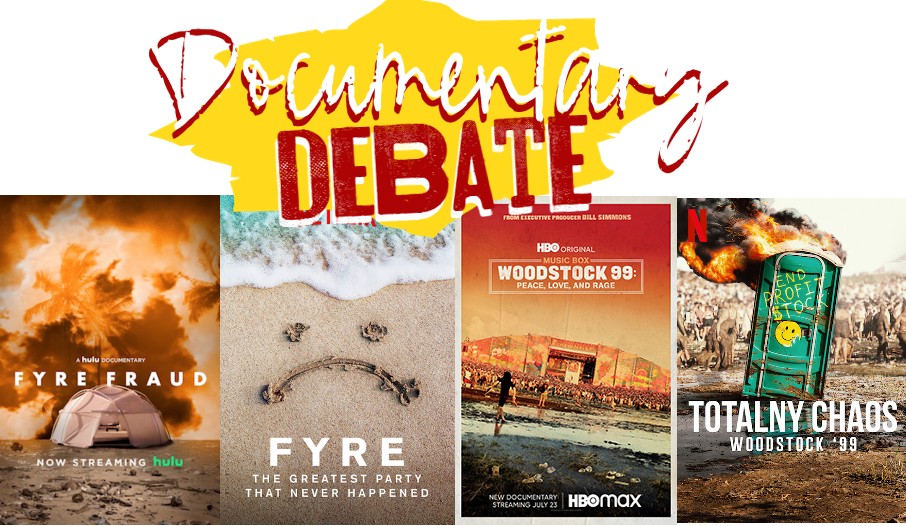Documentary Debate: Failed Festivals Edition

I tend to get obsessed with the weirdest things at the weirdest times. Case in point, just a couple of weeks ago, it occurred to me that I had never seen either documentary on Fyre Festival. After watching, Netflix recommended a docuseries on Woodstock ’99, and only after talking to a coworker about that series did I learn that there was also a documentary about it on HBO Max.
In the past couple of weeks, I have seen each of these way more times than necessary. I am more obsessed with Fyre Festival now than I was when it was actually going down, which was only five years ago. (Alternately, it’s already been five years, can you believe it?) I am learning more about Woodstock ’99 than I did when it happened – which I remember happening, because I’m old.
Watching all of these, which provide very similar yet also very different looks at two very disastrous music festivals, inspired me to write this post. Basically, if you had to pick one documentary on these topics, which one should you watch?
Fyre: The Greatest Party That Never Happened (Netflix) vs Fyre Fraud (Hulu) vs The Con “The Fyre Festival” (ABC)
If you somehow missed the social media firestorm that came about in the wake of the failed Fyre Festival in 2017, let me give you the rundown. The concept was an elite music festival in the Bahamas with luxury accommodations and red carpet treatment for every guest. The reality fell well short of that, with guests stuffed into wet tents and every act pulling out at the last second.
Fyre Festival became a meme, with most people dunking on the attendees for being, essentially, rich kids forced to deal with “substandard” food and transportation. In the years since, more has been revealed about the production of the festival and its co-creator, Billy McFarland, who is currently serving six years in prison for fraud. All of these are explored in both the Netflix documentary Fyre: The Greatest Party That Never Happened and Hulu’s Fyre Fraud, as well as an episode of ABC’s The Con.
So which one is better?
You don’t need to watch the Fyre Festival episode of The Con. There isn’t much that will be revealed here that won’t be in the two documentaries, with a few exceptions. It does feature portions of an interview with McFarland that he gave on a podcast from prison. It also gives some context behind the infamous cheese sandwich photos. But for the most part, this one is entirely skippable. Which works out well, because while Hulu streams the current season of The Con, the Fyre Festival episode aired last year and isn’t streaming anywhere.
Fyre Fraud is a relatively decent overview of everything that went on, with interviews from attendees and festival employees. It also interviews McFarland, before he was sent to prison, in what I think is a pretty illuminating interview. Now, I know that the magic of editing can make it seem like he was taking long pauses when he may not have been, but you can almost see him blue screen when he’s confronted with his various lies. I think Fyre Fraud is worth watching just for that.
Netflix’s Fyre: The Greatest Party That Never Happened is probably the most comprehensive look at everything that went wrong, from the first marketing campaign to McFarland breaking the terms of his bail. Like Fyre Fraud, there are interviews with attendees, employees, and journalists. My one complaint about this documentary is that it was co-produced by Jerry Media, the company that did the social media for Fyre Festival, and I think they downplayed their involvement in what happened. (Conversely, a former employee of Jerry Media is interviewed in Fyre Fraud and is more open about everything.)
When it comes to Fyre Festival, honestly either film will give a very good overview of what happened, but each one tends to focus on different things. Fyre: The Greatest Party That Never Happened concentrates more on the development and implementation of the festival, as well as the aftermath – both for McFarland and for the local Bahamian community. Fyre Fraud seems to be more about McFarland as an individual and has a lot on his early career, as well as an interview with his girlfriend. It also talks a lot about the culture of influencers.
Each documentary (even The Con) has the same general information – even interviews some of the same people – but provides different details. As mentioned previously, The Con gives context to the infamous cheese sandwich. Fyre: The Greatest Party That Never Happened reveals that McFarland had originally secured a private island but lost it after failing to follow the owner’s, like, one rule. Fyre Fraud has a lot more information about what the attendees went through when trying to get back to the United States.
Conclusion: Honestly, I kind of think you need to watch both, just to get the complete picture of everything that went wrong leading up to the disaster that was the Fyre Festival. Ultimately, it depends on which take you want to go with. Fyre: The Greatest Party That Never Happened presents the story of a group of people who genuinely wanted to put on a good festival that were simply in over their heads on a shortened timeframe. Fyre Fraud posits the theory that the festival was a scam from the beginning (which, I mean, it probably was).
My personal pick is Fyre: The Greatest Party That Never Happened. I am just so fascinated by the building of the festival itself and this is the better look at that. But if you’re someone who wants the schadenfreude of watching McFarland be confronted with his lies, you will enjoy Fyre Fraud.
Trainwreck: Woodstock ’99 (Netflix) vs Woodstock ’99: Peace, Love, and Rage (HBO Max)
On the other end of the millennial spectrum is the disaster that was Woodstock ’99. Woodstock ’99 attempted to recapture the magic of the original, five years after the successful 1994 iteration. (Although in doing some mild research for this article I discovered there have actually been quite a few “Woodstock” festivals.) It failed spectacularly in its mission, featuring bands that seemed like the antithesis of the “peace and love” vibe of the ’60s and organizers who were more concerned about making money than providing an enjoyable concert-going experience.
I remember watching the coverage on MTV and just being gobsmacked by the footage. What was meant to be a three-day celebration of music quickly devolved into a rage-filled nightmare, with assaults, injuries, fires, vandalism, and looting. The mitigating factors behind the chaos are explored in both Trainwreck: Woodstock ’99 and Woodstock ’99: Peace, Love, and Rage.
So which one is better?
Trainwreck: Woodstock ’99 is a three-episode docuseries, and as it has a longer runtime, it is able to document more of what happened. It focuses on the organizational issues – present from the beginning – and the overall greed of the organizers. There is a lot about how certain aspects of infrastructure – like sewage and sanitation – were contracted out to companies who did not do their jobs. There is also a lot of talk about the price-gouging that went on, particularly on the final day of the festival, when supplies were limited and prices tripled.
Woodstock ’99: Peace, Love, and Rage delves less into the organizational issues and capitalistic policies and more into the harm done to attendees – the rampant sexual assaults and the fact that at least one concert-goer died. There is mention of the fact that of the multitude of acts that performed, only three of them were women. It talks about how the youth culture in 1999 was vastly different from the one in 1969. It also talks about how the original Woodstock has an idealized reputation that ignores the major issues that happened.
As with Fyre, each Woodstock ’99 documentary provides the same basic overview of what happened. Extreme heat, price gouging, and a general angry sentiment led to an almost post-apocalyptic event. Unlike Fyre, they both have the same general tone and approach. It’s mostly who is providing the information. Trainwreck: Woodstock ’99 tends to focus on the organization and execution; there are interviews with multiple people who were involved in putting on the festival, as well as vendors, security, and EMTs. Woodstock ’99: Peace, Love, and Rage seems to have more interviews with the people affected: attendees, journalists, and the musical acts.
Both documentaries feature interviews with the organizers – John Scher and Michael Lang – and these soundbites will be extremely frustrating to listen to. The men refuse to take accountability for what happened, acting like it was just the actions of a few people and simultaneously glossing over the amount of sexual assaults that happened while blaming the victims. It is, honestly, disgusting, and if I ever meet Scher in person I’m not sure I can refrain from punching him in the face. In both docs, Scher puts the brunt of the blame on the musical acts, primarily Limp Bizkit, and MTV for “setting the tone”.
Conclusion: In an almost opposite move from my Fyre Festival choice, I actually prefer Woodstock ’99: Peace, Love, and Rage just for its examination of the overall culture of the ’90s. But it’s also the fact that it talks about the other terrible things that happened that weren’t just property damage. It’s also shorter, since it’s a film instead of a series.
I do have to mention that both Woodstock ’99 documentaries could be potentially triggering for some people, but Woodstock ’99: Peace, Love, and Rage may actually be the worse one to watch in that circumstance. Please take care of yourselves.
——-
Have you watched these documentaries? Which one do you prefer?
Author: Jamie Sugah
Jamie has a BA in English with a focus in creative writing from The Ohio State University. She self-published her first novel, The Perils of Long Hair on a Windy Day, which is available through Amazon. She is currently an archivist and lives in New York City with her demon ninja vampire cat. She covers television, books, movies, anime, and conventions in the NYC area.
Help support independent journalism. Subscribe to our Patreon.
Copyright © The Geekiary
Do not copy our content in whole to other websites. If you are reading this anywhere besides TheGeekiary.com, it has been stolen.Read our






